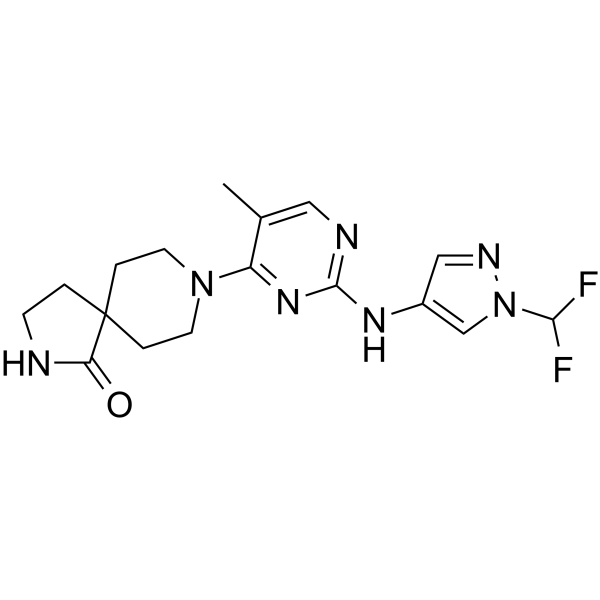JAK1/TYK2-IN-3
Modify Date: 2024-01-09 18:34:05

JAK1/TYK2-IN-3 structure
|
Common Name | JAK1/TYK2-IN-3 | ||
|---|---|---|---|---|
| CAS Number | 2734918-37-5 | Molecular Weight | 377.39 | |
| Density | N/A | Boiling Point | N/A | |
| Molecular Formula | C17H21F2N7O | Melting Point | N/A | |
| MSDS | N/A | Flash Point | N/A | |
Use of JAK1/TYK2-IN-3JAK1/TYK2-IN-3 is a potent, selective and orally active dual TYK2/JAK1 inhibitor with IC50 values of 6 and 37 nM, respectively. JAK1/TYK2-IN-3 also shows selectively relative to JAK2 (IC50=140 nM) and JAK3 (IC50=362 nM). JAK1/TYK2-IN-3 shows anti-inflammatory effect by regulating the expression of related TYK2/JAK1-regulated genes, as well as the formation of Th1, Th2, and Th17 cells[1]. |
| Name | JAK1/TYK2-IN-3 |
|---|
| Description | JAK1/TYK2-IN-3 is a potent, selective and orally active dual TYK2/JAK1 inhibitor with IC50 values of 6 and 37 nM, respectively. JAK1/TYK2-IN-3 also shows selectively relative to JAK2 (IC50=140 nM) and JAK3 (IC50=362 nM). JAK1/TYK2-IN-3 shows anti-inflammatory effect by regulating the expression of related TYK2/JAK1-regulated genes, as well as the formation of Th1, Th2, and Th17 cells[1]. |
|---|---|
| Related Catalog | |
| Target |
Tyk2:6 nM (IC50) JAK1:37 nM (IC50) JAK2:140 nM (IC50) JAK3:362 nM (IC50) |
| In Vitro | JAK1/TYK2-IN-3 (compound 48) (10, 20, 30 mg/kg) shows anti-inflammatory effect by regulating the formation of Th1, Th2, Th17 cells[1]. JAK1/TYK2-IN-3 (10, 20, 30 mg/kg) inhibits the NF-κB signaling pathway by inhibits the JAK-STAT pathway, thereby reducing the inflammatory response in ulcerative colitis (UC) mice[1]. JAK1/TYK2-IN-3 (10, 20, 30 mg/kg) dose-dependently inhibits the mRNA expression of TNF-α, IL-1β, IL-12, IL-17A, IL-22, IFN-α, and IFN-β[1]. |
| In Vivo | JAK1/TYK2-IN-3 (10, 20, 30 mg/kg; p.o.; twice a day for 12 days) shows a good therapeutic effect on ulcerative colitis (UC)[1]. JAK1/TYK2-IN-3 (5 mg/kg, p.o.) shows 23.7% oral bioavailability in rats[1]. Pharmacokinetic Parameters of JAK1/TYK2-IN-3 in male Sprague-Dawley rats[1]. compd dose(mg/kg) Administration Cmax(ng/mL) Cl (Lh-1kg-1) T1/2(h) AUC0-t(ng·h/mL) F (%) 48 5 mg/kg p.o. 400.4±55.3 11.3±5.2 2.4±2.1 440.9±157.0 23.7 Animal Model: 6-8 weeks, 270-325g male Sprague-Dawley rats[1] Dosage: 5 mg/kg Administration: p.o. Result: Showed 23.7% oral bioavailability in rats. Animal Model: Six-eight week old male C57BL/6 mice, 20-22 g (2.5% dextran sulfate sodium (DSS)-induced acute UC mouse model)[1] Dosage: 10, 20, 30 mg/kg Administration: p.o., twice a day, 12 days Result: Improved the infiltration of inflammatory factors and reduced the damage caused by DSS. |
| References |
| Molecular Formula | C17H21F2N7O |
|---|---|
| Molecular Weight | 377.39 |